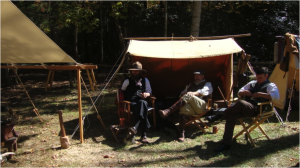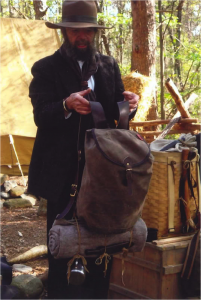By
Steven M. Watts
2004
All human activity results in environmental impact.
Every step and every breath leaves a trace of our passing.
The modern camper/backpacker/outdoor enthusiast relies on gear manufactured in the far-flung corners of the globe. It is then delivered by train, plane, ship or truck—powered by gasoline, diesel or jet fuel. He or she then hits the trail determined to leave no trace while outfitted with a set of lightweight, highly efficient technological wonders (almost all of which, are made from non-renewable resources): tents and packs of nylon, aluminum, titanium and plastic…beautifully designed and engineered stoves burning gasoline, butane or propane…clothes of nylon, Teflon or other exotics…and sleeping systems of petroleum-based bags supported by foam and air.
So equipped, our 21st century adventurer travels to distant and sometimes remote locations (using the same intricate transportations systems that delivered their gear to them in the first place) determined to “take only pictures and leave only footprints”. Few stop to contemplate the global impact of such practices—how many forests are cleared, how many animals eradicated and how much air and water is polluted to provide us with our escape “back to nature”. Seduced by our technology, we fantasize about low impact practices and act as though not leaving behind a campfire scar (no matter what the cost) is the greatest act of virtue to which we can aspire. Or, as David Wescott puts it, “Your campsite may be pristine, but there’s a big hole or a smokestack somewhere in somebody’s backyard”.
Perhaps someday we’ll look back on this time and wonder what in the world we thought we were doing.
The traditional camper/woodsman of the late 19th and early 20th century presents an alternative picture. I speak here of the true followers of the masters (Nessmuk, Horace Kephart, Daniel Carter Beard, Ernest Thompson Seton, Robert Baden Powell, Col. Townsend Whelen), not the tree-hacking, tin-can strewing hordes of chumps that literally hit the woods following World War II. These skilled outdoorsmen took to the camp and trail with gear either bought from domestic or local manufacturers—or as often as not, homemade or retrofitted by themselves. Their tents, bags, ropes, rucksacks and clothes were made from renewable natural fibers—wool, cotton, hemp, linen and silk. Their tools and utensils of iron, steel, copper and tin used precious earth minerals, but were designed to last for scores of generations. They killed animals for food and coppiced the forest, chopping down trees to burn in their fires. Their trips tended not to be quick walk-throughs, but rather outdoor living experiences, meant to put them near a trout stream or simply to enjoy the pleasures and trials of the natural world while “woods loafing”.
They left lots of footprints and took few pictures, but they experienced life in the woods in a way that few of us have. They knew the pleasures of honest grub cooked over an open fire. They experienced the direct relationship between their life in the open and the natural resources around them. And I believe, they would understand that the environmental impact of driving to the modern-day trailhead (and the multinational industries and technologies necessary to make that happen) far exceeds that of their campfires from long ago.
Perhaps some day, we’ll be able to look back with praise for our forbears…realizing what we have lost…and how we have (with all good intentions) fooled ourselves.

Steve Watts (left) with David Wescott (center, author of Camping In The Old Style) in a 1920’s-style demonstration camp… Cradle of Forestry In America, U. S. Forest Service historic site, Pisgah National Forest, North Carolina, 2008
Steve Watts directs the Aboriginal Studies Program and the Traditional Outdoor Skills Program at the Schiele Museum of Natural History in Gastonia, North Carolina. Watts is the author of Practicing Primitive: A Handbook of Aboriginal Skills, Gibbs Smith Publishers, 2004




3 Responses to Traditional Camping And The Environmental Ethic: Trail Food For Thought by Steven M. Watts